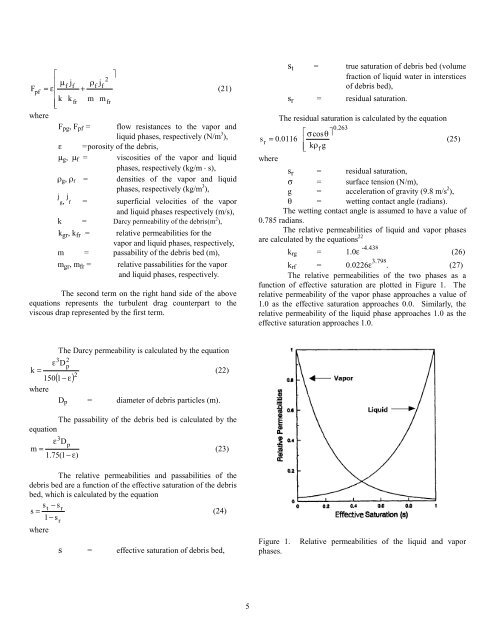SCDAP/RELAP5 Modeling of Fluid Heat Transfer and Flow Losses ...
SCDAP/RELAP5 Modeling of Fluid Heat Transfer and Flow Losses ...
SCDAP/RELAP5 Modeling of Fluid Heat Transfer and Flow Losses ...
Create successful ePaper yourself
Turn your PDF publications into a flip-book with our unique Google optimized e-Paper software.
2<br />
µ ρ<br />
= ε<br />
f<br />
jf<br />
+<br />
f<br />
j<br />
F<br />
f<br />
pf<br />
k k<br />
fr<br />
m mfr<br />
<br />
(21)<br />
where<br />
F pg , F pf = flow resistances to the vapor <strong>and</strong><br />
liquid phases, respectively (N/m 3 ),<br />
ε =porosity <strong>of</strong> the debris,<br />
µ g , µ f = viscosities <strong>of</strong> the vapor <strong>and</strong> liquid<br />
phases, respectively (kg/m ⋅ s),<br />
ρ g , ρ f = densities <strong>of</strong> the vapor <strong>and</strong> liquid<br />
phases, respectively (kg/m 3 ),<br />
j j g, f = superficial velocities <strong>of</strong> the vapor<br />
<strong>and</strong> liquid phases respectively (m/s),<br />
k = Darcy permeability <strong>of</strong> the debris(m 2 ),<br />
k gr , k fr = relative permeabilities for the<br />
vapor <strong>and</strong> liquid phases, respectively,<br />
m = passability <strong>of</strong> the debris bed (m),<br />
m gr , m fr = relative passabilities for the vapor<br />
<strong>and</strong> liquid phases, respectively.<br />
The second term on the right h<strong>and</strong> side <strong>of</strong> the above<br />
equations represents the turbulent drag counterpart to the<br />
viscous drap represented by the first term.<br />
s t = true saturation <strong>of</strong> debris bed (volume<br />
fraction <strong>of</strong> liquid water in interstices<br />
<strong>of</strong> debris bed),<br />
s r = residual saturation.<br />
The residual saturation is calculated by the equation<br />
0.263<br />
sr<br />
= 0.0116<br />
σcosθ<br />
<br />
<br />
kρf<br />
g<br />
(25)<br />
where<br />
s r = residual saturation,<br />
σ = surface tension (N/m),<br />
g = acceleration <strong>of</strong> gravity (9.8 m/s 2 ),<br />
θ = wetting contact angle (radians).<br />
The wetting contact angle is assumed to have a value <strong>of</strong><br />
0.785 radians.<br />
The relative permeabilities <strong>of</strong> liquid <strong>and</strong> vapor phases<br />
are calculated by the equations 22<br />
k rg = 1.0ε -4.43s (26)<br />
k rf = 0.0226ε 3.79s . (27)<br />
The relative permeabilities <strong>of</strong> the two phases as a<br />
function <strong>of</strong> effective saturation are plotted in Figure 1. The<br />
relative permeability <strong>of</strong> the vapor phase approaches a value <strong>of</strong><br />
1.0 as the effective saturation approaches 0.0. Similarly, the<br />
relative permeability <strong>of</strong> the liquid phase approaches 1.0 as the<br />
effective saturation approaches 1.0.<br />
3<br />
The Darcy permeability is calculated by the equation<br />
2<br />
p<br />
ε D<br />
k =<br />
150( 1− ε) 2<br />
(22)<br />
where<br />
D p = diameter <strong>of</strong> debris particles (m).<br />
The passability <strong>of</strong> the debris bed is calculated by the<br />
equation<br />
3<br />
ε Dp<br />
m = (23)<br />
1.75(1 − ε)<br />
The relative permeabilities <strong>and</strong> passabilities <strong>of</strong> the<br />
debris bed are a function <strong>of</strong> the effective saturation <strong>of</strong> the debris<br />
bed, which is calculated by the equation<br />
st<br />
− sr<br />
s = (24)<br />
1−<br />
sr<br />
where<br />
s = effective saturation <strong>of</strong> debris bed,<br />
Figure 1. Relative permeabilities <strong>of</strong> the liquid <strong>and</strong> vapor<br />
phases.<br />
5

















